In the crowded world of social media, how do you stand out without getting lost in a sea of sameness?
The answer lies in a strategy that goes beyond the well-trodden paths of competition and innovation—a strategy called the Purple Ocean. Inspired by the groundbreaking ideas in the book “Blue Ocean Strategy” by W. Chan Kim and Renée Mauborgne, the Purple Ocean strategy combines the best of both Red and Blue Ocean tactics. This hybrid approach is designed to make your brand not just visible but unforgettable.
Kim and Mauborgne’s “Blue Ocean Strategy” revolutionized how businesses think about competition and market creation. They argued that instead of competing in oversaturated markets (Red Oceans), companies should seek out untapped markets (Blue Oceans) where they can innovate without the pressure of competition. But in the dynamic realm of social media, a blend of both approaches can provide a balanced and powerful strategy.
Let’s explore how you can implement a Purple Ocean strategy to dominate existing markets while exploring new growth opportunities and ensuring your social media presence is both competitive and innovative.
Understanding Red and Blue Oceans
First, let’s break down what we mean by Red and Blue Ocean strategies:
Red Ocean Strategy: Competing in existing market spaces, trying to outperform rivals to capture a larger share of existing demand. Think of it as a crowded space where everyone’s fighting for the same slice of the pie. This is similar to the Content Commodity Trap I discussed in the last issue of this newsletter.
Social Media Examples: Trends, Memes, Stock video, generic UGC, Google AdWords, Meta Paid Media
Blue Ocean Strategy: Creating new market spaces or “blue oceans,” making the competition irrelevant. It’s about innovation and differentiation, targeting untapped markets and generating new demand.
Examples: Original content, video, thoughtful and on-brand UGC
Brands fight for differentiation in the Red Ocean and push for separation in the Blue Ocean. You need to do both to be effective on social media.
The Purple Ocean Strategy: Combining Forces
A Purple Ocean strategy fuses the strengths of both Red and Blue Ocean strategies. It’s about leveraging competitive tactics to establish your presence while innovating to set yourself apart. This hybrid approach allows you to dominate existing markets and explore new growth opportunities simultaneously.
How to implement a Purple Ocean strategy for your social media:
1. Analyze Your Competitive Landscape
Understand your market position and identify key competitors. Use Red Ocean tactics to benchmark against them. Analyze their strengths, weaknesses, and social media strategies.
Example: A challenging fitness apparel brand should look at how Nike and Adidas engage their audiences on Instagram and TikTok. By understanding their content strategies, engagement rates, and audience demographics, the brand can pinpoint areas for effective competition.
2. Differentiate Through Innovation
Apply Blue Ocean thinking to differentiate your brand. Identify market gaps or unmet audience needs. Innovate by improving existing offerings or presenting them in a unique way.
Example: Look at how GymShark went all in on alternative forms of media in Instagram, TikTok, and YouTube—using creators to push their product. By honing in on the gym community specifically and aligning with influencers (before the big companies took note), they captured a new market segment. This strategy provides value and sets the brand apart from legacy companies relying solely on traditional product posts and announcements.
3. Crafting Compelling Content
Content creation is at the heart of any social media strategy, and the Purple Ocean approach provides a balanced way to make your content resonate. Let’s talk about memes versus original content.
Memes: Memes are quintessential Red Ocean content. They thrive on existing trends, cultural references, and shared humor. While memes can generate high engagement and quick wins, they are inherently competitive and often fleeting.
Example: A brand that jumps on a popular meme trend can see a spike in likes and shares, quickly catching the audience’s eye. However, the risk is blending in with countless other brands doing the same thing, which can dilute your unique voice.
Original Content: On the flip side, original content is the hallmark of Blue Ocean strategy. Creating unique, thoughtful, and brand-specific content sets you apart and builds a lasting impression. Original content might take more time and resources, but it pays off by establishing your brand as a leader and innovator.
Example: Instead of just jumping on trends, a tech company might create in-depth video series explaining complex concepts in an accessible way. This positions them as an authority and resource, attracting an audience interested in more than just surface-level engagement.
4. Blend Competitive Tactics with Unique Offerings
Combine Red Ocean tactics with Blue Ocean innovations to create cohesion, enhancing current content with unique elements differentiating your brand.
Example: A personal injury law firm in a crowded market can use Red Ocean tactics like targeted Facebook ads showcasing successful case results and client testimonials. Simultaneously, they can adopt Blue Ocean thinking by creating a YouTube channel with free, informative videos on legal rights and personal injury cases, building trust and establishing themselves as thought leaders.
5. Engage and Adapt
A successful Purple Ocean strategy requires constant engagement and adaptation. Monitor your social media performance, track key metrics, and pivot based on what’s effective. Social media changes fast, and you need to take a proactive, not reactive approach to your content.
Example: A beauty brand launching a new skincare line can use Red Ocean tactics like influencer collaborations and sponsored posts. At the same time, they can employ Blue Ocean thinking by developing an interactive app offering personalized skincare advice, creating a unique value proposition.
The Purple Ocean social strategy acknowledges the existing landscape and channels that drive awareness, leads, and sales while still carving out time/money for content that separates your company from the competition.
Other Resources for Brand Social Media
- How to Create a Social Media Plan
- 7 Most Common Mistakes Brands Make on Social (And How to Fix Them)
- How to Hire the Best Social Media Manager





